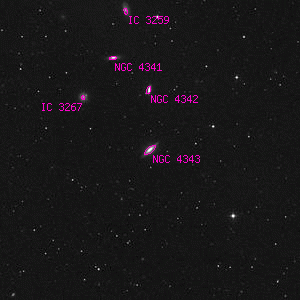NGC 4343

Overlaid DSS image of NGC 4343, 30' x 30' with north at top and west to the right
Aladin viewer for the region around NGC 4343
H III 94, h 1223, GC 2907, MCG+01-32-038, UGC 7465, PGC 40251, SDSS J122338.69+065714.7
| Type | Galaxy |
|---|---|
| Magnitude | 12.1 |
| Size | 1.383' x 0.526' @ 130° |
| Right Ascension | 12h 23' 38.6" (2000) |
| Declination | 6° 57' 15" N |
| Constellation | Virgo |
| Description | pF, S, E, D? |
| Classification | SA |
Observing Notes
Harold Corwin
NGC 4341 = IC 3260, NGC 4342 = IC 3256, and NGC 4343. There is a group of five galaxies here to which three NGC numbers and four IC numbers apply. Needless to say, the identifications are pretty thoroughly scrambled in the literature. Here is the story:
William Herschel (1786) saw three objects (III. 94-96) here, but gave only one position for the them. John Herschel included only one of the objects in his 1833 catalogue, calling it "III. 94," the first of the three numbers assigned by his father. When he prepared the GC, he used his position for this brightest object, but his father's position for the other two, thus giving the lowest of William Herschel's numbers to the object with the largest right ascension. Dreyer used a mean value of John Herschel's position and one from d'Arrest (1867) for the brightest object, but still had only William Herschel's positions for the remaining two. Thus, the inverted order of William Herschel's numbers remains in NGC, with the largest NGC number (4343) receiving the smallest William Herschel number (III. 94).
In sorting out the NGC numbers, I've simply assumed that William Herschel saw the brightest three galaxies here, and that John Herschel and d'Arrest measured the brightest one of these. These three galaxies also have the highest surface brightnesses of the five objects in question, so this is an entirely reasonable assumption to make (see RC3 for the data). This means, however, that the brightest object, NGC 4343, has the smallest right ascension on the sky, but the largest RA in NGC. Also, I've followed RC1 (and most other modern catalogues) by assigning N4342 to the middle of the three galaxies, and N4341 to the remaining (following) object, thus retaining the reverse order.
Bigourdan's observations of 1895 and 1907 of all five objects here yielded four numbers in the second IC. Schwassmann measured four of the five objects on a Heidelberg plate (the fifth object that he did not measure probably appears stellar on the plate). Dreyer used these four accurate positions in IC2; this has led Herzog (1967 and CGCG) to suggest dropping the questionable NGC numbers altogether, and simply use the unambiguous IC numbers instead. RC2 and RC3 adopted this solution.
However, this discards two NGC numbers which we can now assign based on modern photometric data. So, I have adopted the identifications suggested here.
Appendix 6 in RC3 is a table of most known identifications for all five of the galaxies. The curious are referred to it for cross-references into the modern literature and catalogues. You should also see NED for the new names added to these galaxies since 1991.
Other Data Sources for NGC 4343
Associated objects for NGC 4343
Nearby objects for NGC 4343
35 objects found within 60'
Credits...
Drawings, descriptions, and CCD photos are copyright Andrew Cooper unless otherwise noted, no usage without permission.
A complete list of credits and sources can be found on the about page
NGC 4343